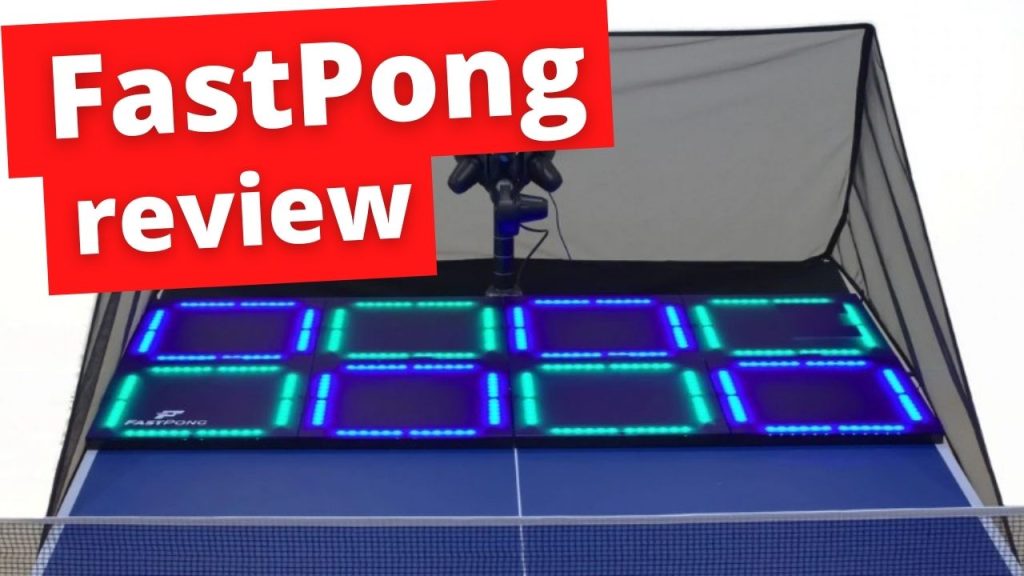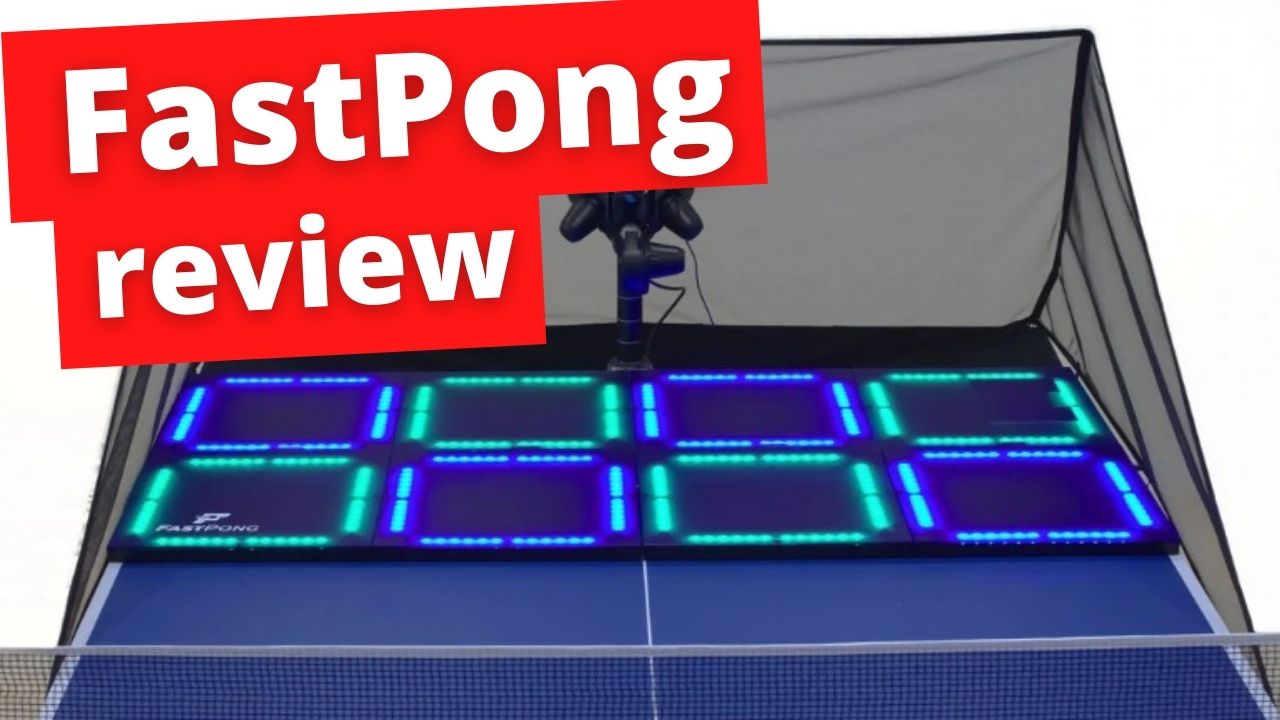
Over the past month I have been testing a brand new product called FastPong. This is a training system to help players improve ball placement accuracy, shot speed and reactions.
I have been using it with my Power Pong robot, but it can also be used without a robot. For example, you can use it for multi-ball training or service practice.
In this review I am going to explain in more detail exactly what the FastPong training system is, and whether it is a useful product to help you improve your table tennis skills.
What is FastPong?
At its most basic, FastPong is a target practice device. There are 4 large panels which connect together. Each panel contains two brightly lit boxes. Overall there are eight boxes. There is a sensor which attaches to your robot. When the sensor detects a ball coming out of your robot, it will light up a box. If you hit the box with your shot, then FastPong will register this as a successful hit.
All of the data is sent to the FastPong app. You can analyse your overall accuracy, the accuracy of your shots in different areas of the table and also the speed of your shots.
This is the most basic application of the FastPong training system, but there is much more it can do, as you will see as we go through this review.
Set up
Setting up the FastPong training system is fairly straightforward. There are four large panels which connect together. The panels are numbered so you know which order to put them on the table.
If you are using FastPong with a robot, then you will need to attach the sensor to your robot. At first I couldn’t quite work out what to do with the sensor and put it in the wrong place. And nothing worked. Scratching my head for a while, I then had my lightbulb moment! The sensor needs to be pointing at where the balls actually come out of the robot. Silly me.
Once I got the sensor into the right position, then FastPong started to work. I tried the sensor in a couple of different positions until I found the position which works every single time. You attach the sensor with some velcro. So you have complete flexibility about where you put the sensor. This means that FastPong should work with any table tennis robot.
Finally there is the FastPong App. You simply connect the app to the FastPong panels and then you can control the system and plan your training sessions.
Now that I know what I’m doing, it takes less than two minutes to set everything up and start using FastPong.
Here’s a short video, where I demonstrate how to set up the FastPong training system.
Using FastPong with a robot
I have mainly been using FastPong with my Power Pong Omega robot. This has added a new dimension to my robot training sessions. Instead of hitting the ball back anywhere, I now have specific targets to aim for. And with the FastPong data collection, I can analyse my accuracy and speed and track my progress.
The FastPong app has three main options when using with a robot:
Sequential mode – Box 1 will light up first, then box 2, then box 3, then 4, 5, 6, 7, 8 and repeat.
Random mode – Any box will randomly light up when a ball shoots out of the robot.
Custom mode – You can select a specific box or boxes you want to aim your shots. For example, you can select boxes 2, 4, 6, 8 and light them up in that order or light them up in a random pattern.
I have mostly been using random mode and custom mode. I use random mode to improve my reactions. I have to stay very alert, as I have no idea which box will light up next. And I have to be quick to adjust my feet and my strokes to hit the target.
Will this help me in my real life games? I think it’s too early to tell. I need to use FastPong over a longer period of time. But I am hoping my reaction speed will improve and I will get better at watching my opponent to see where he or she is moving and then adjust my stroke to play to a different part of the table. My initial feeling is that there will be a benefit. I am playing quite well at the moment, so maybe it’s starting to have an impact already.
For custom mode, there are so many possibilities. But I have started in a very basic way. I have chosen one box, the deep corner box, which is the equivalent of an opponent’s wide backhand area (if right handed). This is an area at the table I’m not very good at hitting, but I need to get better. At amateur level, if you can consistently hit this wide backhand position, you can win a lot of cheap points.
I’ve done this exercise quite a lot. You can watch a video of me doing this exercise. It starts from around 2 minutes into the video. And I am absolutely convinced it has had a positive impact on my game already. In a recent match, against slightly weaker opponents, I hit this wide backhand position so many times and won a lot of easy points. Thank you FastPong!
And of course, when I’m using FastPong all the data of my shots is sent to the FastPong app, so I can track my accuracy levels and the speed of my shots.
Here’s another short video where I give an overview of using FastPong with a robot.
Using FastPong without a robot
You can also use FastPong without a robot. This took me a little while to work out at first. I couldn’t understand how it could work without the sensor. I got in contact with FastPong and they explained what to do.
To use FastPong without a robot, you need to disable the robot mode. Open the FastPong app, and you will see that ‘Robot’ is selected. Simply click ‘Robot’ and then it will be unselected. You can now use FastPong without a robot.
How does it work without a sensor? When robot mode has been disabled, a box will light up, and stay lit up, until it has been hit. When a box has been hit, a new box will light up. Like before, you can use this in sequential mode, random mode and custom mode.
What practical purposes can you use FastPong without a robot? I have used it for service practice. This was pretty useful. I set it up in random mode and then did lots of serves. When analysing my data, I could clearly see there were some areas on the table where I was much more accurate and some areas less so. I then did extra service practice, aiming for those areas where my accuracy was initially lower.
Again, I need to use FastPong over a longer period of time, but I imagine this can really help me tighten up my service placement and improve my placement variation. If I can consistently serve into eight different areas of the table using FastPong, then this will give me more options, and more confidence, when I play real opponents.
The other main way you can use FastPong without a robot is with multi-ball training. I have only tried this at home with my kids. I was the one feeding the balls and my kids were hitting the targets.
My kids loved it. There is an element of gaming which got them very focused. Who can hit the most boxes? They wanted to keep doing it again and again. Eventually I had to tell them it was bedtime!
I think FastPong can add an extra dimension to more serious multiball training too. I sometimes find multiball training a little boring, but I would definitely find it more engaging if I had specific targets to aim for and I could see data about which areas of the table I was hitting the most.
Here’s another short video about using FastPong without a robot.
Other features
FastPong does have a range of other features, but I have not really tested these out.
There is a ‘Doubles’ option, where two players can use FastPong at the same time. There is a ‘Camera’ option where you can record your FastPong training session and send the footage to a coach along with your data. There is a ‘Reaction training’ option where you touch the panels with your hands. And there is an ‘Other games’ option with a couple of additional target practice games.
I’m sure I will try out these options more in the future, but I have been too engrossed in using the core FastPong features so far. And speaking to the FastPong team, it seems there will be more new features in the future. I’m intrigued to see what they come up with.
Overall experience
My overall experience of using FastPong has been very positive so far. I have mostly been using it with my Power Pong Omega robot. It really has added a new dimension to my home robot table tennis workouts. It feels like there is a greater purpose to my robot training and I have loads of data to analyse. I am a bit of a data nerd, so this really appeals to me. I’m also a bit of a ball placement nerd! Ball placement is how I win a lot of my points, so FastPong can help take my ball placement skills to the next level.
But what I am really keen to observe is if my game improves against real opponents. Will my reactions improve? Will my accuracy improve? Will I get better at adjusting my strokes to play to different parts of the table? We will have to wait and see. I need to use FastPong over a longer period of time. However, I do believe I have experienced an initial ‘bounce’ in my form. I do seem a little sharper and my ability to hit the wide, deep backhand position has definitely improved in this past month.
The FastPong technology has been very reliable, once I got the sensor in the optimal position. I have experienced the mobile app freezing occasionally. But I simply close and reopen the app and then it works again. I’m sure the app will continue to improve over time, both its reliability and its features.
The FastPong training system isn’t cheap. It will put a dent in your bank account. So you need to think about whether you are likely to use it a lot. If you have a robot at home, and you use it regularly, then the FastPong training system could be a great addition to your training. If you use FastPong a lot and it helps improve your game, then you will feel like it was a decent investment.
I can also imagine FastPong being used in a club environment, especially if it is a club which already uses multiball or robot training. FastPong is going to bring some extra value to these training sessions and motivate players to keep improving their accuracy percentages and the speed of their shots.
Overall, I’m very impressed with FastPong. Yes, the cost is high. But the technology is really cool and I’m pretty convinced it can have a very positive impact on your table tennis game.
Where to buy
You can buy the FastPong training system directly from the FastPong website.
If you have any questions about the FastPong training system, please do ask me. Either post a question in the comments section below or send me an email at tom@tabletenniscoach.me.uk

